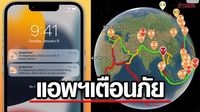On March 28, 2025, at approximately 13:20 Thailand time, a significant earthquake struck Myanmar, registering a magnitude of 8.2 at a depth of 10 kilometers. The tremors were felt across various regions in Thailand, including Bangkok and its surrounding areas. This seismic event resulted in considerable alarm, as buildings swayed and some construction sites faced severe damage, leading to concerns about safety and preparedness for future earthquakes.
The earthquake's epicenter was located near the town of Pang Mapha in Mae Hong Son province, approximately 326 kilometers from the Thai border. According to the National Disaster Warning Center (NDWC), this earthquake is noted as one of the strongest to impact the region in recent history. Reports indicated that the shaking was intense enough to cause evacuations in high-rise buildings, with many residents rushing to the streets in panic.
In light of this incident, the Thai government and officials have faced criticism regarding the effectiveness of the emergency alert systems currently in place. Tairat Nattarattanakul, a representative from the National Broadcasting and Telecommunications Commission (NBTC), stated that while a trial of the Cell Broadcast Service (CBS) was conducted in Phuket in November 2024, the system has yet to be fully operational across the country. "We are close to achieving 100% coverage, but the mountainous terrain in some areas limits the effectiveness of SMS alerts," he explained.
During the earthquake, many residents were unable to receive SMS notifications, raising concerns about the preparedness of emergency services. Tairat emphasized the need for rapid communication in the event of disasters, stating that the CBS would allow for quicker alerts directly to mobile users in affected areas, unlike traditional SMS systems that can be slower due to the need for individual message dispatch.
In response to the earthquake's impact, Khaosod Online recommended the use of the 'QuakeFeed' application, which provides real-time earthquake alerts based on data from the US Geological Survey. The app offers detailed information, including latitude and longitude coordinates, earthquake strength, and geographical mapping features. Available on iOS, 'QuakeFeed' offers a one-month free trial, followed by an annual subscription priced at 249 baht. For Android users, a similar application named 'My Earthquake Alerts' is available, providing comparable functionalities without any associated costs.
Dr. Sanit Phiayleek, a geology lecturer at Chulalongkorn University, commented on the seismic activity, noting that the earthquake's origin was linked to the Sagaing fault line in Myanmar, which has a history of producing significant earthquakes. He explained that the shaking felt in Thailand was due to the resonance effect, where seismic waves impact taller structures more profoundly than shorter ones. "This earthquake is a natural occurrence, with no human-induced factors involved," he clarified, assuring the public that while aftershocks are likely, they are not expected to be as severe as the initial quake.
Dr. Sanit also provided insights into the potential for aftershocks, indicating that while they may occur, they are predicted to be of lesser magnitude. He mentioned that aftershocks could be felt within the next few weeks, but they are unlikely to reach the intensity of the March 28 tremor. "We might see smaller earthquakes in the range of 5, 4, or 3 on the Richter scale," he noted, advising residents to remain vigilant.
As the day unfolded, the effects of the earthquake were evident in various locations. Buildings across Bangkok experienced noticeable shaking, prompting evacuations from shopping malls and office towers. Reports indicated that a 30-story building under construction in the Chatuchak area collapsed, trapping workers inside. Emergency services were deployed to the site, and rescue operations commenced promptly.
In the aftermath of the earthquake, residents expressed their concerns over the reliability of the current alert systems, especially since many were left uninformed during the tremors. The government has been urged to expedite the implementation of the CBS, which could significantly enhance emergency response capabilities. Tairat reassured the public that the system is nearing full operational status, with large-scale tests planned for May and June 2025.
Dr. Sanit urged the public to check their homes and workplaces for any structural damage following the earthquake, emphasizing the importance of safety in the aftermath of such events. He advised, "If you notice any cracks or signs of damage, it’s crucial to have them inspected by professionals. Safety should always be the priority after an earthquake like this."
In conclusion, the earthquake on March 28 has not only highlighted the need for improved emergency alert systems in Thailand but also served as a reminder of the region's vulnerability to seismic events. As the country prepares for future challenges, effective communication and preparedness will be essential in ensuring the safety and well-being of its citizens.






